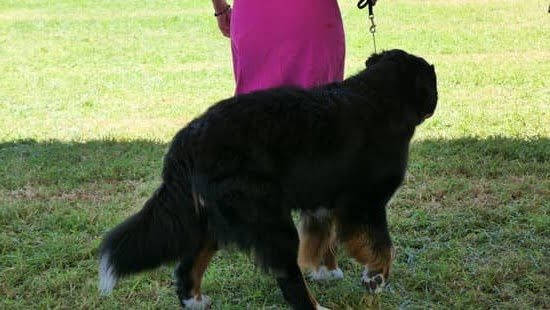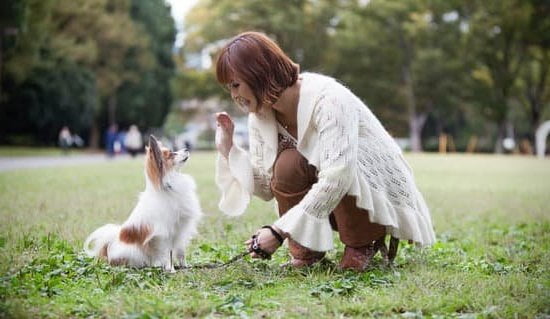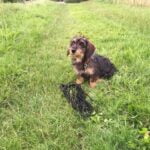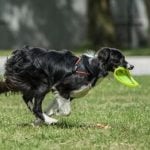Introduction
Training a dog who bites can be extremely difficult and is not something that should be taken lightly. The safety of both the dog and the person being bitten must always be the top priority. It’s important to realize that this type of behavior is usually a result of fear or frustration, so any corrective action taken should be done with patience and understanding. The goal of training is to provide an alternative to biting by teaching other commands such as sit or stay, which can help reduce aggressive behavior when facing certain situations.
In order to effectively train a dog who bites, it helps if one understands why they start exhibiting these behaviors in the first place. Dogs may bite due to fear, aggression, territorial protection, pain or illness, excitement or boredom. Once the source has been identified, it’s important to take steps to ensure that triggers are avoided as much as possible. This might mean getting professional help from a certified animal behaviorist as well as connecting with experienced trainers who specialize in working with dogs displaying violent behaviors.
It’s also important for owners to assess their own reactions when faced with an aggressive situation. Having calm reactions and not punishing the dog will be much more effective than trying to reprimand them while they are already acting out. Engaging in positive reinforcement techniques such as rewarding good behaviors will help encourage desirable responses while avoiding those that are less than ideal. Professional help may also include exposing the pup progressively to different stimuli in an effort to boost confidence levels which may dramatically reduce fear-induced biting episodes over time.
Finally, practicing regular obedience commands such as “Sit” and “Stay” will reinforce your authority in a way that allows you greater control of potentially dangerous situations before they get out of hand. Regular exercise and mental stimulation can also work wonders for helping keep anxiety levels down for dogs prone towards aggressive tendencies so there will always be plenty of preventative measures owners can take that don’t involve physically disciplining their pet. With dedication and commitment from both owner and trainer alike, training a dog who bites doesn’t have to remain an insurmountable task.
Establishing Ground Rules
When training a dog who bites, it’s important to set ground rules through clear verbal cues and body language. This helps your pup understand what behaviors are acceptable and which are not. Start by teaching basic commands, such as “sit, stay, and come.” This can provide an effective way of finding the cause of your dog’s biting problem. Additionally, through basic training commands, you can provide your pup with an outlet for its energy and frustration.
Also, having a good understanding of dog body language is essential when dealing with dogs that bite or exhibit aggressive behavior. Grouping facial expressions into three categories—relaxed/happy, mild stress/caution and fear/aggression—can help identify which areas require the most focus during obedience training sessions. With practice, you can recognize more subtle signs that signal danger or potential stressors in your pup’s environment before a bite encounter occurs.
Additionally, establishing boundaries for your pet to adhere to creates predictability in their world and helps build trust between the two of you. By supervising interactions such as playtime with other pets or people in the home and consistently reinforcing proper behaviors with positive reinforcement like praise or treats can help establish healthy boundaries for your furry friend in the long run. You should also avoid physical contact (such as hugging) if it’s not mutually desired or accepted by both parties since this might give them mixed signals or provoke aggressive behavior over time.
Redirecting Unwanted Behavior
The first step to training a dog who bites is to identify the triggers for their biting behaviors. Once you understand what causes your pup to lash out, it’s important to quickly and calmly intervene in order to prevent any further aggression. To do this, first determine the best way to physically interrupt the unwanted behavior. This could involve turning away from them, making a loud noise, or using gentle pressure on the body as a warning signal that they should stop.
Once you have successfully interrupted the barking or biting episode, redirect the pup’s attention to an acceptable activity such as playing with a chew toy or fetching a treat-stuffed toy. During this time, be sure to provide positive reinforcement each time your pup completes the desired behavior. With continued repetition and rewards for correct behavior, your pup should begin to associate performing alternative actions with being given treats and affection.
For more severe cases it may also be useful to establish boundaries by limiting access to certain areas of your home in order to create more space between your pup and people or other animals they are likely to bite. Giving consistent verbal cues like “leave it alone” can help reduce the number of times they feel tempted by those triggers again in the future. Consistent reinforcement for good choices will eventually lead them away from their biting habits and towards better behaviors.
Using Positive Reinforcement
Biting is a common problem with certain breeds of dogs and even some puppies. It can be a scary ordeal for owners and other people, as well as a damaging habit that needs to be curbed. The most effective way to train a dog who bites is through positive reinforcement.
Positive reinforcement involves rewarding good behavior while discouraging bad behavior through praise, treats, and fun toys. Start by providing treats when the dog has appropriate behavior – maybe wag its tail on greeting or simply not biting something it used to bite. Then gradually reduce the amount of treats given once the desired behavior becomes consistent and rewards are earned less often. Additionally, praising your pet with words like “good boy” or “good girl” can help reinforce the behaviour you want from them. Finally, providing interactive toys like stuffed animals and chew toys can help occupy their attention away from potential targets for aggression.
Overall, it’s important to remain consistent with your training approach, continually praise good behaviours and reward with treats or playtime as needed. Consistency will eventually pay off as behaviors become less frequent until they cease altogether over time – potentially leading to a calmer, happier pooch!
Creating a Positive Environment
Training a dog who bites can be a challenge, but it is possible as long as you take proper precautions and build a foundation of trust through positive reinforcement training. First and foremost, the environment must be kept pet-friendly, which means removing any potential triggers that could contribute to the dog’s desire to bite. Anything in the home that might make the dog feel anxious or fearful should be removed. For example, the presence of children and other animals or loud noises can all serve to increase stress levels in dogs. If these triggers cannot be removed from the home entirely, it is important to limit their exposure as much as possible by establishing clear boundaries for when these stimuli are allowed in the house.
It’s also important to create space for your dog to relax and regroup by having an area that is solely reserved for him or her. This should include comfortable bedding materials, toys, chew items and a quiet corner where he or she can retreat if feeling overwhelmed or scared. Additionally, mind-stimulating exercises such as playing fetch, teaching tricks, and providing interactive puzzle toys can help keep an active dog entertained while servicing their mental needs. Lastly, socialization plays an important role in introducing your pup to new people and pets while teaching bite inhibition techniques that prevent them from lashing out with aggression when they feel threatened.
Exercising and Socializing
Exercising and socializing have a significant effect on the behavior of a dog who bites. From reducing anxiety and stress to providing relief from boredom, exercise and socialization are an effective tool in changing undesirable behaviors such as aggression and biting. Dogs require a daily routine that includes appropriate physical exercise to be healthy, happy, and well-mannered. Exercise can also help stimulate your pet’s mind which is key in stifling negative or destructive behaviors.
Socialization is equally important for dogs who bite or have aggressive behaviors as it can help them become acclimated to new dogs, people, environments, and situations. Socialization can reduce fearfulness in dogs which may contribute to aggressive behaviors like biting. It’s important that socialization starts at an early age but it is never too late to help a dog who has problems with aggression learn how to properly behave around other animals and people.
To train a dog who bites, start by ensuring these two aspects of his/her life are being taken care of every day: exercise and socialization. As you work to change the negative behavior through positive reinforcement training, make sure he/she has plenty of opportunities to get out into different places while developing sounds habits when faced with potential triggers like barking other dogs or unfamiliar humans. Start slow – smally increases your pup’s exposure and reward with rewards whenever good behavior is exhibited. When combined with consistent training, this approach will see success in creating a happier, healthier pup celebrating good behavior over uncomfortable aggression outbursts.
Habitual Behavior Modification
When it comes to training a dog who bites, it is important to understand that this established pattern of biting is a habitual behavior. Habitual behavior must be addressed in order to make long-term changes that will stop the biting. To do this, you must first identify the triggers and patterns that lead up to the dog’s biting. Examples might be a particular stressor or sound when approaching people, or even if they are excited or playing too rough with other dogs. After identifying these triggers and patterns, you need to take proactive steps to interrupt this chain and reinforce alternative desired behaviors.
To begin breaking this established pattern of biting, try redirecting your dog before they resort to biting by rewarding them for good behavior (e.g., providing treats when they respond in an appropriate manner). If your dog does bite, it’s important not to scold them but focus instead on teaching them acceptable boundaries through positive reinforcement and redirection (by e.g., giving them something else to chew on). When disciplining your dog for bad behavior, ensure you use short and direct verbal commands along with gesture cues (such as pointing your finger at the ground) so that the command can be easily interpreted. Moreover, provide proper exercise for your pup (through walks or playtime) as this will help stimulate their body and mind which reduces likelihood of aggression given out of frustration or boredom. All these steps together can help create lasting behavioral change in how your pup interacts with people securely and appropriately.
Seeking Professional Help
When dealing with a dog that bites, it is important to seek professional help. A certified dog behavior specialist or trainer can provide the tools and guidance needed to train your dog. Depending on the severity of the biting, different methods may need to be employed in order to properly train your pet.
If the biting is infrequent but still alarming, then a general training program could be beneficial. This includes using positive reinforcement techniques like verbal praise and treats when your pet exhibits good behavior. The goal of this type of training is to create a consistent and rewarding reward-and-consequence environment for your pup that encourages desirable behaviors and discourages undesired ones.
In cases where biting has become more frequent and alarmingly aggressive, then it’s recommended that you seek out a specialized trainer or behavioral specialist who has experience with managing aggression in dogs. This type of individual will have a deeper understanding of canine body language, making them better qualified to recognize and respond appropriately in challenging situations. They will also be better equipped to provide individualized instruction based on viewing interactions between your pet and family members in order to best identify any triggers or patterns associated with aggressive behavior.
With significant patience and determination along with the assistance of an experienced professional, you can train your pup how to behave correctly without resorting to aggression or biting – establishing a relationship between you both built on trust rather than fear!
Conclusion
It is important to have patience and consistency when training a dog who bites. Allowing the dog time to relearn acceptable behavior is essential. Positive reinforcement training methods, such as using treats and verbal praise, can help create a bond between owner and animal and make it easier for the dog to learn new behaviors. Implementing these tips may take time, but will be beneficial in the long run for both you and your dog as it creates trust and eliminates bite incidents. With dedication, patience, and understanding of why the biting is happening in the first place, training a dog who bites can be successful.

Welcome to the blog! I am a professional dog trainer and have been working with dogs for many years. In this blog, I will be discussing various topics related to dog training, including tips, tricks, and advice. I hope you find this information helpful and informative. Thanks for reading!





